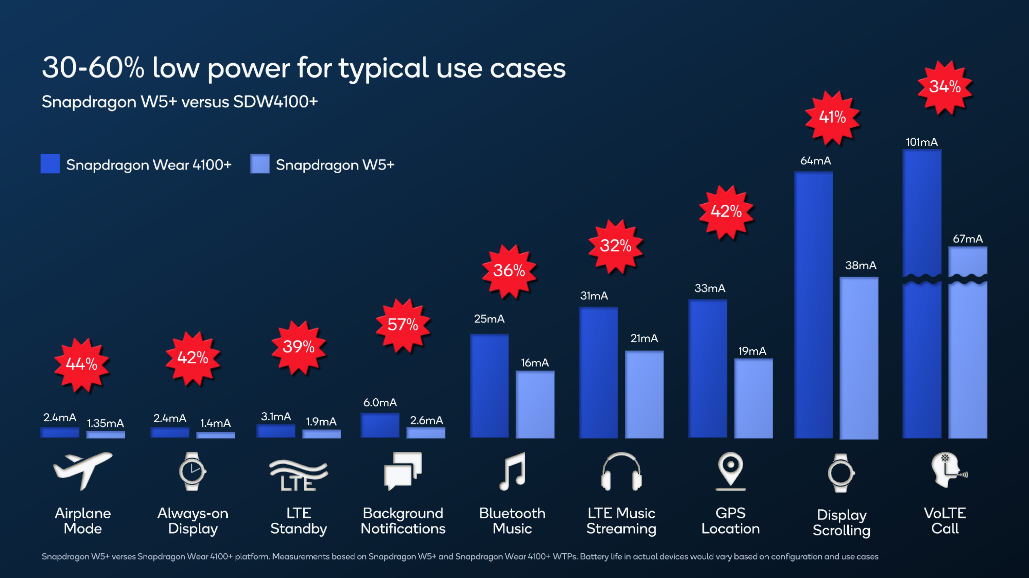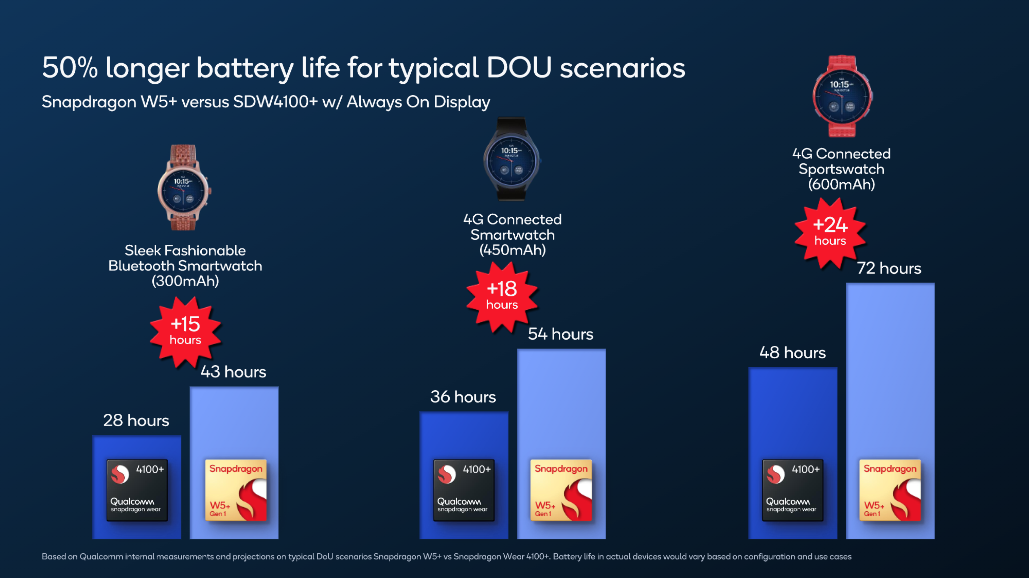
Google’s Wear OS platform has long been the laughing stock of the wearable community, but tides are finally shifting. After years of neglect, Wear OS is finally getting a fair shot.
There’s been a lot more to get excited about in the Wear OS world over the past year or so. The Snapdragon Wear 4100 series bolstered Fossil’s latest crop of watches to be pretty solid performers, and the Galaxy Watch 4 ushered in Wear OS 3. Plus, Google is finally, actually making a Pixel Watch!
But today saw the biggest boost to the Wear OS market to date – Qualcomm is finally making a good chip. That’s one of two things that is clearly giving Wear OS a chance to actually grow and thrive.
Qualcomm trades the bare minimum for maximum effort
It can’t be understated how impactful today’s reveal of the Snapdragon W5+ Gen 1 chip is.
Qualcomm has been the key name in chips for Android-powered smartwatches since the platform was known as Android Wear, but the company has always presented the bare minimum.
2016’s Snapdragon Wear 2100 had some smartwatch optimizations but was built on ancient technology. The chip used a 28nm process, a far cry from the 14nm process that Qualcomm’s Snapdragon 820 from the same year used. At the time, that was largely fine. Android Wear wasn’t particularly demanding, and the smartwatch market was still in its early days.
Two years later, though, Qualcomm doubled down on using that ancient tech with the Snapdragon Wear 3100, which was effectively the same chip but with a co-processor to offload a few tasks. The pressure was on at that point. 2018’s Snapdragon 845 was using a 10nm process, and Google’s platform was demanding more out of performance. A 28nm chip was actively holding Wear OS back, and even doubling the amount of RAM was only going so far in improving performance.

With Qualcomm’s pattern set, that meant waiting two years to get the next chip in place. That timing did not work out at all, given the smartwatch market really started to grow in 2019, and COVID struck in 2020, only further boosting wearable demand, but leaving Wear OS behind. Qualcomm eventually released the Snapdragon Wear 4100 series later in 2020 with a much improved 12nm process, but it was too late to capitalize. Mobvoi was the only customer of the 4100 series for nearly a full year, and Fossil’s offerings on the 4100+ were middling at best. Google had moved on to greater things, working up its Wear OS 3 upgrade which was announced in 2021 and later debuted on the excellent Samsung Galaxy Watch 4 series.
Now, Qualcomm has finally turned things around. The Snapdragon W5 and W5+ are built on a far more efficient 4nm process with big promises for performance and battery gains – and frankly, we believe them. The Galaxy Watch 4’s 5nm chip trounced what Qualcomm was offering before, so a Snapdragon chip one-upping Samsung should at least be in the same realm.


And the important thing here is that this chip isn’t just for one device. Samsung still hasn’t made the Exynos W920 in the Galaxy Watch 4 series available to anyone else, but the Snapdragon W5 series will be available to basically everyone. Mobvoi and Oppo are already on board, and it’s hard to imagine that Fossil won’t jump on the opportunity within the next several months or so.
Chips have always been the core problem for Wear OS. Google’s platform in itself was rather good, but held back by poor performance that also hindered apps. But that was always a “chicken and the egg” situation. Qualcomm had no incentive to make better chips for smartwatches people weren’t buying, and people didn’t want to buy smartwatches held back by these problems that came from the chip.
Finally, Qualcomm has stepped up to solve the problem, and combined with Wear OS 3, it’s a perfect storm to give the platform the breathing room it’s always needed.

Google is giving Wear OS the Android model
But beyond just the chip which, again, has always been the core problem, Google is also making Wear OS a far more flexible platform.
During its inception as Android Wear, Google explicitly said that its OEM partners would not be able to alter the platform as they do with traditional Android phones. An Android Wear smartwatch would be identical on a core software level whether it came from Motorola, Samsung, Sony, LG, or anyone else – side note: wow, there were so many partners back in the day.
That’s a rule that Google has slowly eroded away at over time. Some partners would include custom apps, others would tweak colors for the system. Mobvoi started including its own app drawer in recent models, and over the past two years Google has opened up heavy customization to some partners overseas, such as Oppo.
But Wear OS 3 is the real tipping point.
Samsung was our first sign of what was to come. The Galaxy Watch 4 runs a version of Wear OS that’s unrecognizable from Google’s flavor. It doesn’t use the Wear OS app, and everything functions differently. The only elements that make their way over are the Play Store, some key system elements, and the apps – sound familiar?
Wear OS is very clearly adopting the Android model, where Google provides a core operating system that its partners have the authority to adjust to suit their needs. Some will make heavy customizations, like Samsung. Others, like Montblanc, seem more satisfied with Google’s designs.

But outside of the watch itself, this also allows smartwatch partners to better connect with their customers. No longer will a single app be used for every smartwatch. Samsung has its own. Montblanc has its own. Fossil is working on its own, and everyone else will be, too; even Google has a “Pixel Watch” app in the works. While this creates a headache for folks like me who run multiple smartwatches, it’s great news for the average customer.
Smartwatch makers can build an app that fully encompasses the experience they want to build, from pairing to management to fitness.
Will it work out?
But the real question here boils down to where we go from here – the stars are aligned for Wear OS to finally see some meaningful growth and success. But has too much damage already been done? Samsung is clearly happy and finding success with its switch to Google’s platform, but can Mobvoi, Fossil, and other brands actually recover from years of being left to fend for themselves?
Really, we’ll have to wait and see. But one thing is clear – there’s never been a better time to look for a smartwatch to go with your Android phone.
More on Wear OS:
- Snapdragon W5+ Gen 1 battery life – Here’s what to expect from future Wear OS smartwatches
- Montblanc offers a good look at Wear OS 3 without Samsung’s skin
- Fast Pair coming to Wear OS for quick headphone pairing ahead of Pixel Watch
FTC: We use income earning auto affiliate links. More.



Comments